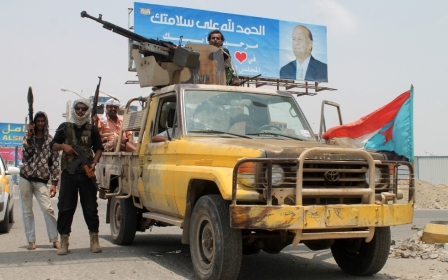25 years after unification, Yemen's separatists gaining ground

MUKALLA, Yemen - A quarter of a century ago, Yemen was a hopeful place, recalls Aqqel al-Attas from Mukalla in southern Yemen.
He says he remembers watching the television as senior politicians cheerfully raised the flag of the newly established Republic of Yemen in the port city of Aden.
“There was intense excitement and happiness in the city of Mukalla,” Attas said, when recalling the unification ceremony that took place almost exactly 25 years ago.
Today however, Attas and many people who experienced the unification with joy are calling for secession and for an independent state for South Yemen. With violence raging and various sides pitted against each other on the ground, Attas and many other southerners fear that continued unity will mean nothing but more trouble.
Back in 1990, when Yemen was united, unification was seen as a solution to a wave of wars in the southern Gulf.
The process wasn’t easy. The former Marxist Yemen Democratic Republic and the former tribal dominated Arab Republic of Yemen officially became the Republic of Yemen, after years of sporadic talks that eventually resulted in a deal penned on 30 November 1989.
Abdul Bari Taher, a veteran Yemeni journalist and political analyst who lives in the north also remembers watching those same images on 22 May, 1990. He says he can still clearly remember the spontaneous and ecstatic celebrations that swept the streets of Yemen to celebrate the birth of the new nation.
“It was a great event and people thought it would put an end to conflicts either between south and north or within each state,” Taher told Middle East Eye via telephone from his house in the Yemeni capital. “People were dreaming of a country with law and order.”
Most people believed that there were a range of benefits to be had.
“People in the south thought that they would get rid of the repressive Socialist Party,” said Attas.
Since the country’s independence in 1967, South Yemen had been ruled by Russian-allied socialists who created a system of government akin to Cuba, some critics go as far as equating it to North Korea.
“People hated the socialists when they nationalisd properties and suppressed Islamic figures,” Attas told MEE.
Attas said that shortly after the ratification of the unity deal, the tightly closed south opened its market to the north, allowing traders to bring in rare products for the first time in decades.
“The south was closed mentally, socially and economically. In the past, mango cans were given out only with a prescription - like medicine,” Attas said while recalling the harsh rationing system enforced by the old leadership.
Southerners who lived during the communist period say that the demand for unifying the two parts of Yemen was chanted daily in schools and in public gatherings.
“We were raised with slogans glorifying unification with the north,” Attas said.
Waning celebrations
But annual celebrations, held to mark the occasion, have begun to wane in recent years as secession sentiments have grown and the separatist Southern Movement has gained momentum.
This year, celebrations even disappeared from national TV. With the country arguably in the midst of a civil war between the powerful Houthi movement – backed by former president Ali Abdullah Saleh - and the rival president Abd Rabbuh Mansour Hadi who has fled to Saudi Arabia, few were in a mood to mark the occasion. The only notable celebration across the country was a humble military parade in the Hadi-controlled Mareb province.
Hadi is a southerner but has traditionally not enjoyed a great deal of support there. This has shifted slightly since the Houthis began marching south, storming the capital Sanaa last September and then moving all the way down to Aden by March of this year.
Their advance prompted the once peaceful Southern Movement (known locally known as Hirak) to take up arms against the Houthis and Saleh’s forces.
This umbrella organisation for a string of secessionist groups has now become the driving force behind the strong resistance against the Houthi presence in the south
Yemen analysts say that Houthis’ continuing military actions in the south have boosted pro-independence sentiment, scuppering all efforts by recent governments to win hearts and minds of the disgruntled southerners.
“The fate of unification depends on the course of the Houthis' military expansion,” said Ali al-Fageh, the editor of al-Masder daily newspaper.
“The country will fall apart if they win the fight as it will stoke up secession demands. But there is hope to mend the unification if the Houthis lose their grip on the country.”
Slippery slope
For many analysts, like Taher, the root cause of the problem goes back to the early years of unification. Shortly after the country was reunited, tensions flared up between the two sides after a wave of assassination bids targeting members of the former ruling Socialist Party who resided in the newly unified Yemeni capital, Sanaa.
In 1993, Ali Salem al-Beith, the vice president and former president of South Yemen, angrily travelled to Aden and refused to return to Sanaa citing fears for his safety and that of his party.
The growing tension led to a civil war in April 1994 that ended when the forces of the former president Ali Abdullah Saleh entered Aden in July of the same year, forcing Beith and senior socialists into exile.
Some analysts now believe that it was this early war that turned the unification from a blessing to a curse and insist that it helped to sow suspicions and tensions that have now exploded once again.
Taher, the Sanaa-based journalist, said: “This great event [unification] turned into a real disaster for which the country is still paying a heavy price.”
Following the civil war, tens of thousands of army officers and public servants from former South Yemen were forced to retire. Southerners said that the winners pillaged lands and monopolised power and wealth. Years of marginalisation set the stage for a popular secessionist movement to spring up across the south and for the formation of the Hirak in 2007.
“The war was a plot against the unification by the rulers of the north who exclusively dominated the political domain after removing their former partner, the southerners,” Taher said.
Attas also felt that Saleh’s government should have addressed the southerners’ grievances by reinstalling the cashiered soldiers and public servants. Instead, Saleh accused the protesters of trying to split the country and took a heavy hand.
“The pro-independence movement sparked when military pensioners gathered in Aden in 7 July 1994 to demand equal pay with their peers in the north,” said Attas.
He explained that some senior figures like Hassan Baoum, now a hard-line separatist, and Haidar al-Attas, former prime minister, proposed an initiative in 1996 to correct the course, including asking for soldiers to be reinstated and a federal system introduced. But Saleh once again took a heavy approach. Hundreds were killed and thousands arrested in the ensuing crackdowns.
The years of repression have been hard on the separatists, but the current conflict has given them hope that a new South Yemeni state will eventually rise up from the ruins.
This week, the separatists’ morale recieved a big boost when they regained control of Dhale from the Houthis. It’s the first southern city to be governed totally by separatists and many will be watching events here to see if they are a precursor of wider change to come.
Middle East Eye propose une couverture et une analyse indépendantes et incomparables du Moyen-Orient, de l’Afrique du Nord et d’autres régions du monde. Pour en savoir plus sur la reprise de ce contenu et les frais qui s’appliquent, veuillez remplir ce formulaire [en anglais]. Pour en savoir plus sur MEE, cliquez ici [en anglais].




